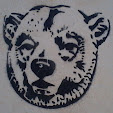Royal Horse Artillery I think; they could
be some esoteric Yeomanry regiment, but I don't think Malleable offered such rarities in their exhaustive, but
complicated - to follow - list (which I
have somewhere and will post one day), so RHA until I know otherwise.
The figures appear to be hollow and have
had their headdresses drilled to receive their hackles as very small slivers of
plastic. Note also; the two very different bases, one; an integral moulding,
the other; a glued-on piece of sheet material which appears (from the
distortion) to be a phenolic or acetate of some variety. A situation which
bears reflection;
There were other, earlier makers of
plastics of interest to us, Bergan
and German WHW types being the
obvious, but Malleable were trying to
invent a technology (or applications thereof) without the support the Nazi
regime might have given their plastics industry before the war (IG Farben,
polystyrene - 1929), or the booming economy of post-war America, but in an economy
broken by the same war which had proved such a boon to the US.
Consequently, the fact that they produced
such a variety of figures and figure types; whole mouldings, assembled
kits-of-parts, integral bases, separate bases and soft polyethylene figures,
hollow and solid; in such a short life and from both ex-metal and original
moulds, in stable and unstable paint finishes, should come as no surprise to us
now, and the work they did must have benefited those who came after . . . all
of whom (Zang-Herald, Timpo, Charbens, Cherilea and Crescent) adopted the polyethylene Malleable were using at the end, but
most adding chalk for paint adhesion!
And if you think that last point is a bit off-the-wall,
keep watching this space.
A Life Guard or 'Royal', I've always
preferred the Horse Guards or 'Blues', they are one unit now, anyway and that's
him; blurb done!





No comments:
Post a Comment